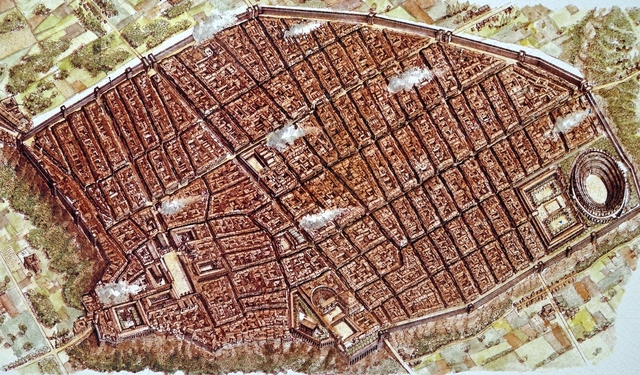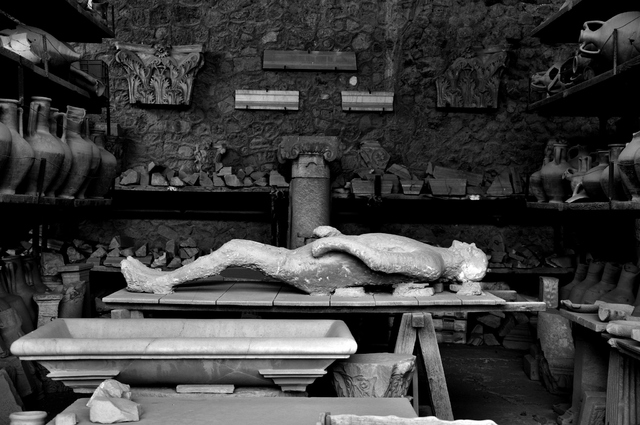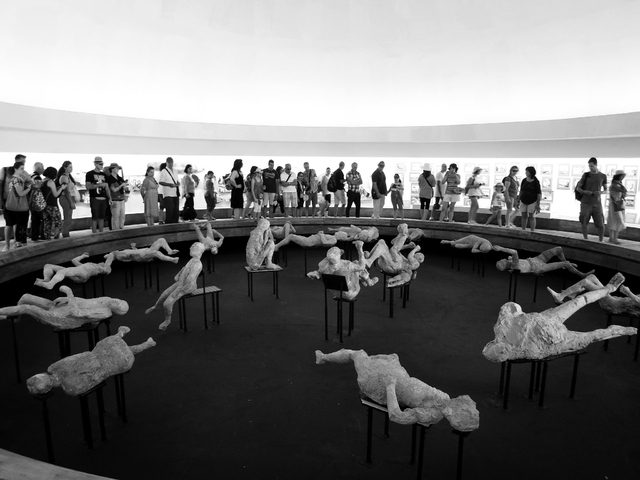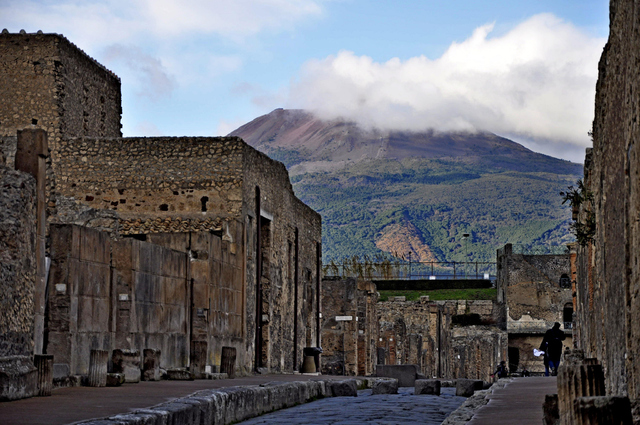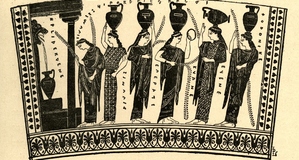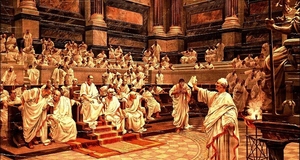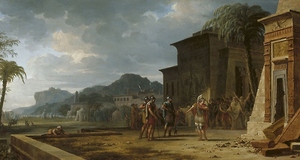Featured Article:Re-Understanding Pompeii: A History of our Interpretation of the Lost City
By
2015, Vol. 7 No. 10 | pg. 1/2 | » AbstractThe catastrophic demise of the Oscan-Roman city of Pompeii in 79 A.D. left its mark on our collective psyche. Its remains have long been a staple of archaeology and ancient history curricula while its demise is described in countless books and has served as inspiration for artists since ancient times. Two motifs that recur in discussions of the ancient city are those of mortality and sexuality, both themes that oscillate between the realms of fascination and taboo. This paper will use cognitive methodologies within archaeology to analyse the layers of semantic baggage that have been loaded onto the site since its interment. By showing the ways in which the site has been repossessed as a vehicle of our own desires and fears, it will elucidate the more subliminal aspects of our relationship with the ancient world. Today Pompeii is a site predominantly known to the public for three reasons: its tragic destruction and simultaneous preservation, its remarkable story of excavation, and its reputation as a hotbed for debauchery. These three elements are key parts of the historical discourse surrounding the Roman town, a discourse which has been in flux since its initial ‘rediscovery’.1 When Pompeii was first uncovered, archaeology was still in its infancy and religious mores were the main guiding principles within society. The culture of the discoverers became the lens through which the site and its inhabitants were seen and understood. As archaeological methods and the social ethos changed, so did interpretations of the site. Through its uncovery, Pompeii developed into a cognitive landscape, encoded with meaning. The Vesuvian town became an obsession for artists and antiquarians alike, capturing the public imagination as a ‘window on the ancient world’.2The examples that follow will shed light on the various ways in which the site of Pompeii and its artefacts were imbued with cryptic layers of significance after its resurrection in the eighteenth century. This will ultimately aid in exploring the concept of cognitive historiography as it pertains to the site of Pompeii, especially focussing on how it serves as a reminder of man’s innate lot in death and as a symbol for sexuality and repressed desire. The study of cognitive archaeology and historiography is quite a recent affair, stemming from the debates between processual and post-processual theorists within the discipline.3 The cognitive method focuses on the ‘thinking practices’ of past civilizations and how we are able to perceive these through literary and material culture.4 This theory has been criticized by various other schools of thought, most notably by processual archaeologist Lewis Binford. He states that ‘paleopsychology’5 is not a valid field of study as the mind is universal, and thus it is the environment, not the human actors, which determines human behaviour and can effect change.6 Pompeii in Images: (left to right) a map of what the ancient city of Pompeii might have looked like in its prime; a victim of the eruption at Mt. Vesuvius; more preserved bodies; the streets of Pompeii. First photo: Dennis Jarvis CC-2. Other photos: Carlo Mirante CC-2. Although we can agree that the idea of inferring ancient thought from artefacts is debateable, by reversing the focus of this research frontier, it becomes a stimulating method to explore how the societies to which the archaeologists and historians belong interact with the sites of the ancient world. In relation to Pompeii cognitive theories have been employed to determine whether or not our modern interpretation of the ancient evidence coincides with the inhabitants’ own world views. Through such studies many impressions of the town have been revealed to be our own retrojected sensitivities. By looking at our own modern discourse on Pompeii and inferring the ideologies behind it, we can better understand how our own systems of thought have developed and where their source truly lies. This requires an interdisciplinary method including elements of historical, archaeological and psychological analysis applied to our own adaptations of the Pompeii myth. This is especially important when it comes to ‘taboo’ subjects such as mortality and sexuality, which are repressed in most modern day-to-day discourse and must therefore be expressed through alternate means. By extracting these from the narratives of the past we can better understand the paradigms of the interpreters and how they conceived the taboo subjects and interacted with the ancient site. The primary way in which Pompeii appears in the ancient sources is as a site of tragedy and devastation. Its cataclysmic destruction in a ‘storm of fire’7 has since been embraced by artists as an embodiment of ‘the Sublime’, exemplifying the terrifying and magnificent power of nature.8 According to Burke’s concept of ‘the Sublime’ this term did not merely describe something that was beautiful or aesthetically pleasing, but it held an inherent existential question and a compelling necessity to react. This instinctive response is one of instant repulsion and pain at the sight of something so jarring. Simultaneously the viewer feels attraction to its power and a delight in knowing he is not embroiled in the horror.9 It underscores the vast emptiness and silence that occurs after a cataclysmic event, the ‘erasure of the human presence’.10 In the eighteenth and nineteenth century this took the form of dramatic landscapes. Such images of the desolate Roman town falling to ruin, become repositories for our own terrors, a way to externalise them by displacing them onto an outlandish scene. John Martin’s painting ‘The Destruction of Pompeii and Herculaneum’ for example depicts a nocturnal apocalyptic scene where the human element is overshadowed by the destructive force of the mountain. This served as an evocative image of the ‘awe inspiring power of nature’ and its ability to create and destroy.11 However, these images never directly displayed the loss of life, choosing instead to focus on the visual and emotional impact of the event itself.12 The sheer potential for natural forces to completely overwhelm human life remains a universal threat, spanning across time. Through stories, the site becomes more than just a repository for abstract concepts of the Sublime and mortality. The ruined city is populated with recognizable characters allowing the public to connect with the remains on a personal level. Representations in art and literature allowed the contemporary population to build a connection to the site, making it a symbol for many later disasters, even into our own time.13 The ability of the site to ‘express the unspeakable’ today extends beyond the power of nature to the human disasters of the Holocaust and Hiroshima, providing a shifting metaphor adapting to contemporary needs.14 Beyond being an artistic and literary motif, Mount Vesuvius became a vehicle of divine retribution in the minds of the public.15 Although Pompeii itself has no evidence of a widespread Christian population, they fit quite well within Christian notions of God’s capacity to destroy and subsequently regenerate, as in the great deluge.16 In the second century BC the Sibylline Oracles, believed to be composed by the Jews of Alexandria, noted a great eruption that would destroy the Campanian region.17 This prediction according to Shanks was easily re-interpreted after the tragedy from a Jewish standpoint as evidence for the eruption being a display of ‘the anger of the God of heaven’. 18 His two main sources of evidence for this were the references to Sodom and Gomorrah in relation to the events at Pompeii in the second century Christian writer Tertullian’s Apologies; and the graffiti scratched into a Pompeian wall painting not long after the event stating ‘Sodom and Gomorra’.19 After the excavation, these findings came to imply a connection between the licentious reputation of the colony and its ultimate ruin. Thus the town became more manifestly appropriated as a setting for projecting contemporary anxieties about our own vices and the final judgement. An example of this can be seen in Bulwer-Lytton’s comparison between the town upon its destruction and the darkness and fire of hell.20 In most ancient sources the destruction is simply referred to as a tragic but remarkable event.21 A second element, connected to the religious reinterpretation of Pompeii is the sites potential for evoking man’s fear of his own mortality. This is most clearly reflected in the interest for the plaster-casts, preserving the semblance of the inhabitants of Pompeii in their moment of death. They appeared at a time when preservation of artefacts was becoming an important part of historical discourse. Early on they were presented as a process by which scientists could recreate the forms of human bodies and more evidence could be gained about the site.22 Its potential for attracting public interest was only realized later, after photographs had been disseminated through mass media.23 Since the inception of this method in the 1860s, the plaster casts have continued to captivate the attention of audiences, in contrast to the fluctuating interest that other aspects of the site evoke.24 They are seen as a way to counteract the constant degradation of our knowledge of ancient sites, and more personally, a way to deter the loss of the individuals who lived in them. In our fear of being forgotten we feel the need to preserve the memory of the lives of those who preceded us. Through our personal identification with these individuals they gain a posthumous life. This creates a dormant intimacy between the living and the deceased that is rekindled upon the uncovering of their imprints.25 These casts are often interpreted as the physical bodies of the victims or as ‘statues’26, in reality they are anti-bodies, evidence for the cavities left behind by the long since decomposed human remains.27 They represent a lack of matter, but through their exposition as sculpture they become recognized as works of art.28 These casts allow us to empathize with individual bodies, creating a non-historical link between the viewer and the tragedy.29 We become witnesses to the most isolated instants of the victim’s life, and yet these figures are given no right to privacy, having become artefacts or works of art. Mary Beard describes this as a modern voyeuristic obsession with these chalky white figures forever stuck in limbo between death and life.30 An example of this can be seen in Alan McCollum’s work, ‘The Dog of Pompeii’, his repetitive process of copying the cast of the writhing animal was meant to represents the ‘sad absence of a whole world we’ll never retrieve again’.31 The impression given is rather one of sinister discomfort in witnessing a moment of utter pain and torment. He is forcing the viewer to engage with the urge to return to an earlier state of being often through re-enacting traumatic events, termed by Freud as the death drive.32 The modern methods used would normally be juxtaposed with the ancient material, but in this case they become inherent to their visualisation by the general public. The plaster casts become the physical bodies of the deceased and the reconstructed roads are equated with those walked upon by the Pompeians themselves, although in both cases the context has been completely altered. The excavation and reconstruction of the site creates a tension between the factual recording and the conceptual recreation of the ancient world. The plaster casts and the site more generally are a constant reminder of our own ephemerality as well as our ability to transcend death through memory. The paradoxical ability of the eruption to simultaneously destroy and safeguard the site for later generation is one of the main ways in which the site of Pompeii has been defined in the post-classical period, especially in the minds of archaeologists and historiographers.33 Another taboo theme that has been in the forefront of Pompeian scholarship since its uncovering is that of sexuality. Classical settings have long been used to enable the exploration of erotic themes in art, subjects that would be considered inappropriate in a contemporary context.34 However, as this iconography was ubiquitous in the classical, and especially the Roman world, they could not be ignored by those uncovering and studying them.35 By placing these elements in a distant past they become acceptable additions to the artistic repertoire. Upon their unveiling in the eighteenth and nineteenth centuries these finds were viewed as ‘disreputable objects of pagan licentiousness’.36 The sexual imagery proliferating in the Vesuvian towns was believed to substantiate a decadent lifestyle, where pleasure was the main goal of life. This also fit into their theory of the eruption of Vesuvius being a manifestation of divine punishment for Roman vulgarity. However, this theory does not coincide with the rest of the archaeological evidence which suggests a highly productive town.37 As stated above, the moralistic frameworks of sin and prurience are concepts that emerged after the destruction of Pompeii, and must be seen as anachronistic views of Pompeian imagery.38 In these early periods the finds were not analysed in order to better understand Roman ideas on sexuality, but rather to validate the view of history held by those in charge of the excavation. The cognitive agency of these artefacts has been shaped by the way in which later audiences were ‘socialized to perceive ancient sexuality ’.39 The erotic artefacts from the ancient world were initially locked away becoming testimonies to the ‘clash of worlds’ that ensued between the people who used them and their new modern audience. Much of what was held to be perverse would have been innocent images in the eyes of a Pompeian. Phallic images were apotropaic and often meant to stimulate ridicule, while many images featuring nudity depicted mythological scenes meant to manifest the sacred sphere. It is clear then that sexuality is not an a-historic concept, and that the distinction of sexual artefacts is a way for scholars to make sense of something seen as foreign, often essentializing it in the process.40 Even in more recent years, the taxonomy still reflects our own sense of sexuality and morality rather than its original context. The site’s ability to invoke our own inner desires is brought to the psychological plane in the writings of Gautier and Jensen. The themes of sexuality and the repression thereof were extremely popular in nineteenth century literature. As this was the period of romanticism, the site serves as a perfect setting as it is seen as a place where the past comes to life, encoded within the remains of the ancient town. Instead of focusing on the observation of nature as external to human experience, this movement emphasized the inner self. Pompeii then became a locale, situated in an ancient Golden Age, where the confines of rationality could be escaped and desires could be embraced.41 It seems to reflect an ever-changing state of mind rather than a fixed physical place.42 In Gautier’s Arria Marcella (1852) Octavien becomes enthralled by the imprint of Arria’s bosom exhibited in the Naples Museum, and after spending an illusory evening with her, is cast back into reality, permanently affected by his revelations in Pompeii.Continued on Next Page » Suggested Reading from Inquiries Journal
Inquiries Journal provides undergraduate and graduate students around the world a platform for the wide dissemination of academic work over a range of core disciplines. Representing the work of students from hundreds of institutions around the globe, Inquiries Journal's large database of academic articles is completely free. Learn more | Blog | Submit Latest in History |

